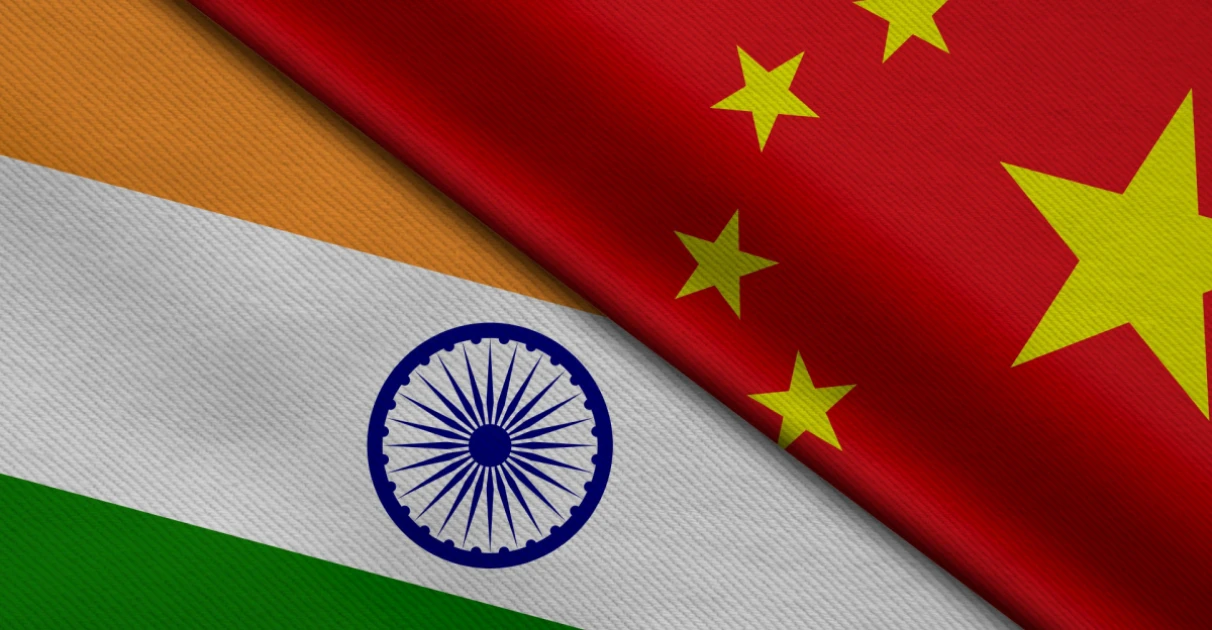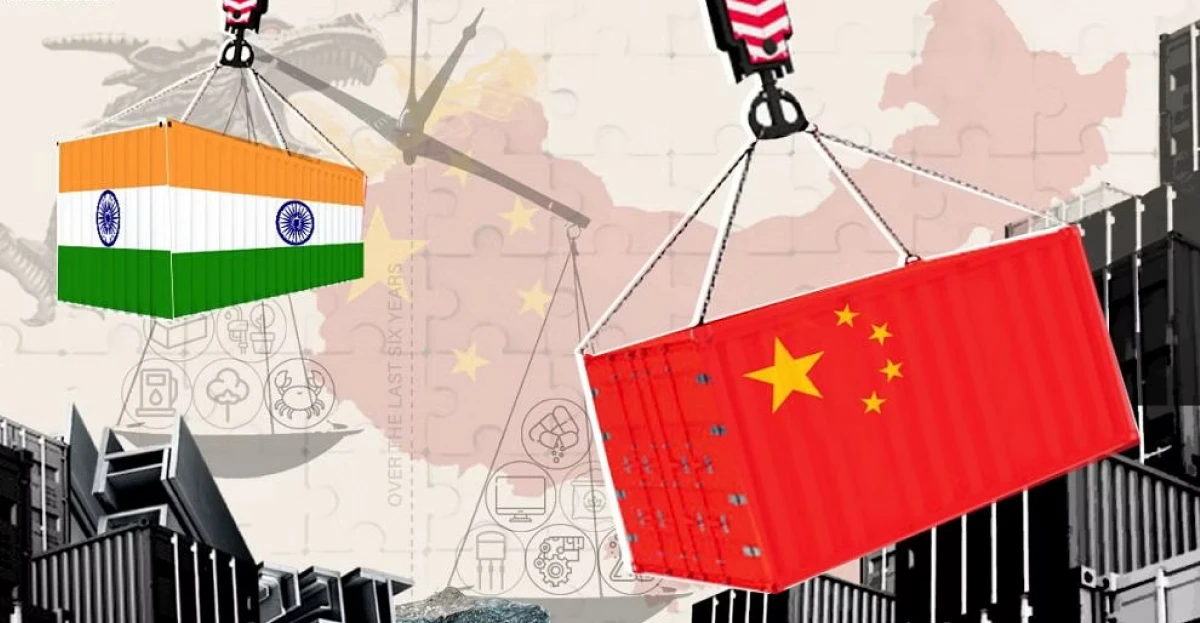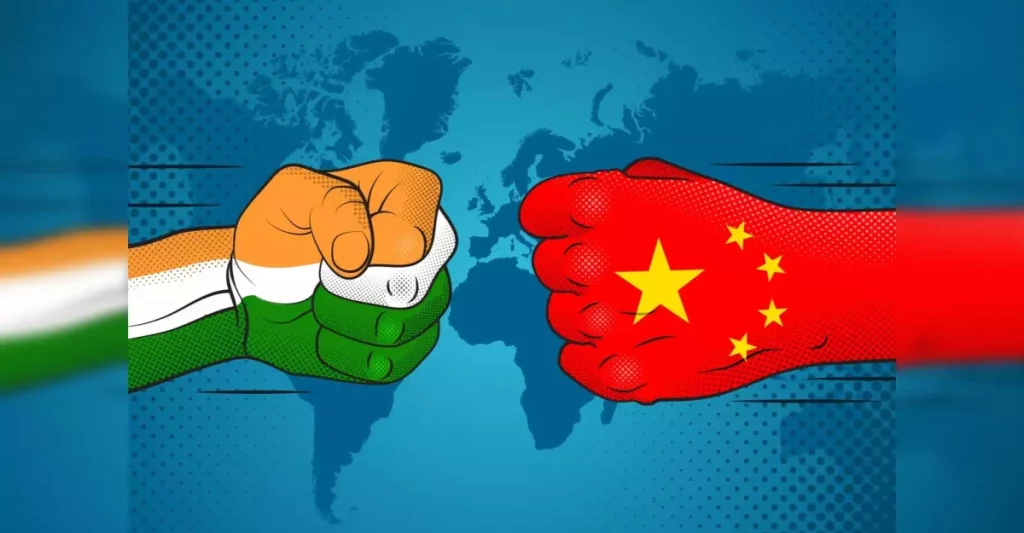Recently, the growth trajectory of the India vs China economy has become a topic of discussion. Reason? It is a competition between neighboring countries!

India has been experiencing strong economic growth, with its GDP growing at 6.1% last quarter, outpacing China’s growth rate of 4.5%.
Do you know, the research from the Brokings Institution suggests that India may grow at an average 3.5% faster than China from 2020-2045.
Now that’s no less than a plot twist!
By the way, which is better placed for growth? You may ask.
Go through the following write-up, and you will find out soon!
(A) Synopsis of India vs China Economy

China and India are the greatest dynamic duo in the global economic scene!
Why? You may ask.
In 2023, China proudly claims the silver spot for the world’s second-largest economy, while India rocks the fifth place in terms of nominal GDP.
But here’s the twist – when it comes to purchasing power, China takes center stage as the number one, with India securing a solid third position. Together, they’re like the power siblings holding over 20% (nominal) and a whopping 26% (PPP) of the world’s wealth.
Now, let’s rewind to 1988. Back then, these economic powerhouses were practically hand in hand in terms of nominal GDP, and in 1990, China was just nudging ahead in PPP terms.
But wait for it… fast forward to 2023, and China’s GDP is strutting around like a rockstar, being a whopping 4.74 times larger than India’s in nominal terms and 2.51 times in PPP terms.
China hit the $1 trillion mark in 1998, throwing a glamorous economic party, and India decided to join the celebration nine years later in 2007 based on exchange rates. Okay, let’s dive into the past.
Back in the year 1988, China and India were like two peas in a pod when it came to GDP per capita. India even had a moment in 1990 when it was wealthier by both measures.
But here’s where the plot thickens – by 2023, China is nearly 4.8 times richer than India in nominal and 2.54 times in PPP. China’s like the high roller sitting comfortably at 75th place in nominal GDP per capita, while India is at 143rd. In PPP terms, it’s a similar story – China’s at 77th, and India’s holding strong at 131st.
Now, let’s dive into the emotional rollercoaster of GDP growth.
China with its crazy ups and downs – hitting a whopping 19.30% growth in 1970 and facing the gap with a -27.27% low in 1961.
Meanwhile, India’s reaching for the stars with a record high of 9.63% in 1988 but taking a heart-wrenching dip to -5.83% in 2020. China had more than a fair share of double-digit growth in 22 years from 1961 to 2022, making India feel like it’s chasing the dragon.
Both countries, though, had to endure the bitter taste of negative GDP growth in five different years. Now, let’s add some drama with the sector-wise GDP composition in 2017.
India’s like a trio – 15.4% from Agriculture, 23% from Industry, and a whopping 61.5% from Services.
Meanwhile, China’s playing its own tune with 8.3% from Agriculture, 39.5% from Industry, and a cool 52.2% from Services, according to the CIA Factbook.
Both are busy with their unique economic rides!
(B) India vs China Economy: Key Differences
Let’s talk about some data first.
India’s current economic landscape bears resemblance to China’s situation in 2007. According to Moody’s analytics, India’s economy has recently surpassed USD 3.5 trillion and is anticipated to surpass USD 3.7 trillion in 2023, akin to China’s historical economic scale.
In terms of per capita income, China recorded USD 2,694 in 2007, while the International Monetary Fund (IMF) projects India’s per capita income to ascend from USD 2,379 in 2022 to USD 2,601 in 2023.
Although there are certain parallels between India’s current economic state and China’s in 2007, the distinctions between them are more pronounced and bear consequential implications for India’s trajectory of growth. These divergences play a pivotal role in shaping the future development of India’s economy.
In subsequent sections, we will delve into a comprehensive analysis of the India vs China Economic landscape.
| Particulars | India | China | Takeaways |
| Investment to GDP Ratio | High growth phase around 33%, fell to around 29% (2012-2021) | Averaged around 40% (2003-2011), almost 43% (2012-2021) | China’s consistent high investment contributes to rapid growth; India’s lower ratio may impact growth potential. |
| Twin Balance Sheet Issue | Twin deficit problem (Current Account Deficit and Fiscal Deficit) affecting investment landscape | No Issue | India’s twin deficit problem poses challenges to economic growth by weakening the value of the rupee. |
| Composition of Exports & Imports | Exports over USD 770 billion, imports around USD 890 billion (2022-23) | Exports exceeded USD 1.2 trillion (2007), imports USD 950 billion | China’s higher integration into global trade evident from substantial export and import figures |
| Tariff Rates | Dropped from 25.63% (2003) to 8.88% (2017), but increasing since then | Consistent reduction (10.69% to 5.32% in 2020) | China’s lower and declining tariff rates facilitate global integration; India’s increasing rates may impact investment. |
| Labor Force Participation Rates | Estimated at around 50% (2022) | Gradual decline from almost 73% (2007) to around 67% | China’s historically higher participation rate reflects a more engaged workforce |
| Employment Generation-Formal Manufacturing | Significant jobs in construction and services, but limited in formal manufacturing | Formal manufacturing highly productive, limited job opportunities | India faces challenges in generating formal manufacturing jobs, impacting overall economic growth potential. |
| Female Labor Force Participation Rate | Lower at 30% (2007), further decreased to 24% (2022) | Declined from 66% (2007) to 61% (2022) | Lower female participation in India’s workforce compared to China may have socio-economic implications. |
These key differences shed light on the disparities between China and India across various economic dimensions, influencing their growth trajectories and global integration.
(C) Key Similarities of India vs China Economy
Although the similarities aren’t that much but we found a certain degree of similarities in the two aspects described in the table-
| Aspect | India (2021) | China (2007) | Key Observations |
| Sectoral Distribution of the Labour Force | 44% Agriculture,25% Industry,31% Services | 41% Agriculture,27% Industry,32% Services | Similar patterns in labor distribution, with slight variations. Both countries have a substantial agricultural workforce. |
| Decline in the Labour Force in Agriculture | Rate of decline around 1% per year | Rate of decline around 1.5% per year (2003-2019) | Both nations experienced a gradual shift away from agriculture, albeit at different rates. Future employment challenges in India pose questions for effective transition. |
(D) Which is Better Placed for Growth: IMF’s Projections on India vs China Economy
(D.1) Nominal GDP (billions $)
Nominal GDP is the total value of all goods and services produced by a country in a specific time period, usually a year, without considering inflation or changes in prices. It’s like looking at the raw, actual numbers of a country’s economic output.
| Year | India | China |
| 2023 | 3,732.22 | 17,700.90 |
| 2024 | 4,105.38 | 18,560.01 |
| 2025 | 4,511.85 | 19,781.70 |
| 2026 | 4,951.62 | 21,059.83 |
| 2027 | 5,427.39 | 22,291.05 |
| 2028 | 5,944.38 | 23,608.86 |
(D.2) PPP GDP (billions Int. $)
PPP GDP stands for Purchasing Power Parity Gross Domestic Product. It’s a way to measure and compare the economic output of countries, considering the relative cost of living and inflation rates. In simple words, it helps us understand how much a country’s money is worth in terms of buying goods and services globally.
| Year | India | China |
| 2023 | 13,119.62 | 32,897.93 |
| 2024 | 14,261.18 | 35,042.69 |
| 2025 | 15,469.08 | 37,220.76 |
| 2026 | 16,765.19 | 39,487.61 |
| 2027 | 18,155.68 | 41,682.47 |
| 2028 | 19,650.22 | 43,889.88 |
(D.3) Nominal GDP Capita ($)
This term refers to the Nominal Gross Domestic Product per person, which is essentially the average economic output per individual in a country. It gives us an idea of the average income of the people in a nation without adjusting for inflation.
| Year | India | China |
| 2023 | 2,612 | 12,541 |
| 2024 | 2,848 | 13,156 |
| 2025 | 3,102 | 14,031 |
| 2026 | 3,375 | 14,952 |
| 2027 | 3,668 | 15,844 |
| 2028 | 3,985 | 16,803 |
(D.4) PPP GDP Capita (Int.$)
Similar to Nominal GDP Capita, PPP GDP Capita takes into account the Purchasing Power Parity. It provides an estimate of the average income per person, considering differences in the cost of living and inflation rates between countries.
| Year | India | China |
| 2023 | 9,183 | 23,309 |
| 2024 | 9,892 | 24,839 |
| 2025 | 10,635 | 26,401 |
| 2026 | 11,426 | 28,035 |
| 2027 | 12,271 | 29,626 |
| 2028 | 13,173 | 31,237 |
(D.5) Growth (%)
Growth percentage is a measure that tells us how much a particular economic indicator, like GDP, has increased or decreased over a specific period. It’s expressed as a percentage and gives insights into the overall economic performance and progress of a country.
| Year | India (%) | China (%) |
| 2023 | 6.332 | 5.010 |
| 2024 | 6.293 | 4.160 |
| 2025 | 6.327 | 4.117 |
| 2026 | 6.316 | 4.071 |
| 2027 | 6.349 | 3.663 |
| 2028 | 6.263 | 3.380 |
The data on the IMF’s projections for the economies of India and China unveils a captivating narrative of growth and potential. Looking at the nominal GDP figures, India is on a trajectory of impressive expansion, reaching $5,944.38 billion in 2028.
However, China’s colossal economy maintains a commanding lead at $23,608.86 billion in the same year. Delving into per capita values, India’s nominal GDP per capita is climbing steadily, reaching $3,985 in 2028, though it pales in comparison to China’s $16,803.
The story is equally compelling in terms of Purchasing Power Parity (PPP) GDP, where India is making strides, projected to hit $19,650.22 billion in 2028. The growth rates reveal India’s consistent upward momentum, outpacing China marginally, showcasing its resilience and potential for robust economic development.
This data paints a dynamic picture, signaling India’s promising growth path, but in the gigantic shadow of China’s economic might.
(E) Way Forward for India vs China Economy: Strategies to Opt to Surpass China

India is eyeing a promising future in the global economic arena, and the path forward involves strategic initiatives to outpace China. Let’s explore some compelling strategies-
(E.1) Ramp Up Investment Activity
To propel economic growth, India plans to attract both domestic and foreign investments. This involves creating a business-friendly environment, streamlining regulatory procedures, and offering incentives to industries. By fostering a robust investment climate, India aims to emulate China’s success in this domain.
(E.2) Supercharge Exports
India intends to boost its global footprint by identifying sectors where it holds a comparative advantage. The strategy involves improving infrastructure and logistics to enhance export capabilities. Providing robust support to exporters will further catapult India into the league of top exporting nations.
(E.3) Empower Female Workforce
Recognizing the pivotal role of women in the workforce, India is focused on increasing female labor force participation. This entails implementing gender equality measures, ensuring access to education, and developing skills. By harnessing the potential of its entire population, India aims to rival China’s labor force dynamics.
(E.4) Ignite Formal Manufacturing Environment
A key strategy involves creating more employment opportunities in the formal manufacturing sector. India plans to achieve this by implementing policies that foster sectoral growth, integrating advanced technologies, and implementing comprehensive skill development programs. This move aims to boost productivity and elevate the status of the manufacturing industry.
(E.5) Sustain Investor-Friendly Climate
India acknowledges the importance of a conducive investment climate. The nation is committed to continually improving the ease of doing business, reducing bureaucratic obstacles, enhancing transparency, and strengthening governance. These measures are designed to attract investments and sustain economic growth, mirroring China’s successful approach.
(E.6) Prioritize Education and Skill Development
Recognizing the transformative power of education, India plans to invest significantly in education and skill development programs. This initiative aims to equip the workforce with the skills necessary for the evolving job market, fostering innovation, and nurturing entrepreneurship, ultimately enhancing India’s economic prowess.
(E.7) Fortify Infrastructure Backbone
A critical element of India’s strategy involves prioritizing infrastructure development. This encompasses enhancements in transportation, logistics, power, and digital connectivity. A robust infrastructure backbone is vital to supporting economic activities, facilitating trade, and positioning India as a formidable economic force.
(E.8) Forge Global Collaborations
India recognizes the importance of collaborative efforts on both regional and international fronts. Actively engaging in partnerships aims to expand market access, integrate into global value chains, and leverage opportunities for growth and development. This strategy aligns with China’s successful approach of fostering global collaborations for economic advancement.
In essence, these strategies outline a comprehensive roadmap for India to not only compete with China but also surpass its economic prowess in the years to come. The future holds immense promise as India strategically positions itself on the global economic stage.
Note: Do you know despite having a great fortune, China’s economy has multiple loopholes? Go through the article on “What’s wrong with the Chinese Economy.”
(F) Summing Up: India vs China Economy
India emerges as a highly compelling prospect for global businesses, boasting a vast market, a sizable and skilled labor force, and a stable governance structure. Positioned ideally for manufacturing and investment, the country stands at the threshold of significant opportunities. However, to fully realize its potential, India must proactively undertake strategic reforms and cultivate a conducive business environment.
Through these measures, India can strengthen its position as an exceptionally attractive hub for businesses on the global stage. Let’s hope to see this result soon!

